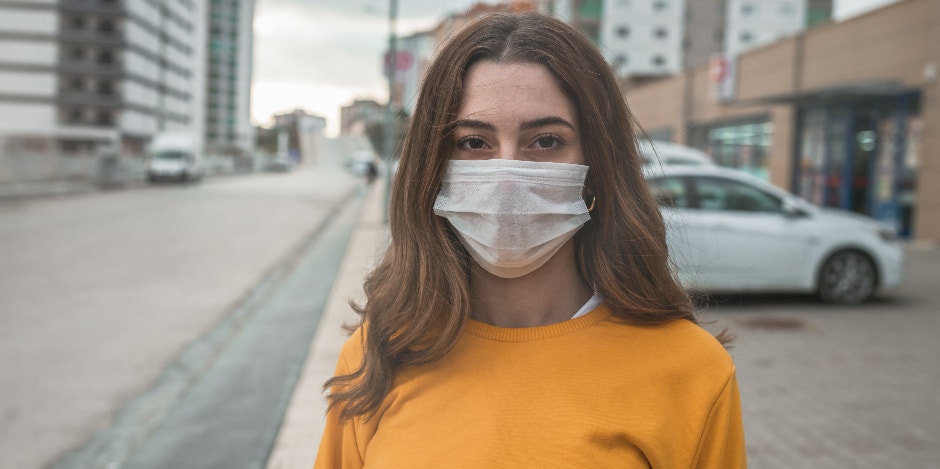Why Wearing A Mask Can Trigger Panic & Shame For Trauma Survivors
It's a surprising trigger.
 getty
getty People with PTSD are facing some issues with wearing a mask while trying to combat the spread of COVID-19.
Trauma survivors routinely face a bevy of problems other people might not realize. For instance, I know of a veteran who had a panic attack while wearing her mask at the grocery store recently.
She said it immediately reminded her of when she was deployed in Afghanistan, in a confined situation where she couldn't breathe. The mask was triggering her post-traumatic stress disorder (PTSD) from her service in the military.
She didn't know what she's supposed to do now that masks are required in order to slow the spread of COVID-19. This left her feeling as if she must choose between the panic while wearing her mask, or receive shame from strangers if she aborts her mask in public.
Choosing between panic attacks and public shame.
She isn't alone. Many people with a history of PTSD are having similar dilemmas. They can choose to wear a mask and have high anxiety or panic, or they can choose not to and then receive glares and shaming comments from others.
It can feel as if they need to wear a sign over their head letting the public know about their PTSD and why they're choosing not to wear a mask.
Here in my state of Colorado, Governor Polis mandates people wear a mask in public unless they have a medical condition that prevents it. I understand this and support that social distancing and wearing a mask does indeed slow down the virus.
The dilemma is that some who struggle with PTSD face the issue of wearing a mask and have a panic attack, or don’t wear a mask and get shamed for not putting others at risk.
This is a choice that survivors should not have to make.
There is no way to know how many trauma survivors are walking among you. Yet people feel free to judge harshly without even knowing someone’s story.
Here are some glaring statistics that hopefully help you understand why there could be a lot of people choosing not to wear a mask.
In the United States, 61 percent of men and 51 percent of women have experienced at least one traumatic event in their life. With these statistics in mind, how do you prioritize safety and still be respectful toward others?
Unless you have a neon sign lit over your head, how will others know that you do indeed have a medical reason not to wear a mask?
If you have not experienced PTSD, you may be wondering how a simple piece of cloth on your face can be so disruptive.
Here are some common reactions from PTSD survivors when wearing a mask:
- The mask feels suffocating. A lack of oxygen flow creates immediate fear of impending doom.
- Seeing a mask on someone else can be a reminder of a perpetrator.
- The mask prevents being able to read someone else’s lips or facial expressions to be able to interpret a sense of safety or need to self-protect.
- The mandate to wear the mask removes a sense of choice in the matter. This lack of choice triggers the loss of control, which is like living a trauma all over again.
Trauma is stored in the body.
Even though shopping in a grocery store is typically safe, the body is connecting certain stimuli to past trauma. In other words, the body doesn’t know the difference between past and present.
Expert trauma specialist Bessel Van Der Kolk, MD, wrote a book called The Body Keeps The Score, in which he describes how bodies remember the trauma and how the brain attaches to stimuli from past experiences. Those stimuli get locked in the brain and similar situations such as smells, sights, and other body sensations can trigger the brain into thinking it's unsafe and in danger.
A perfect example of this is an experience a former bank teller had recently when she had to wear a mask at her grocery store. At work, she had been robbed at gunpoint.
Then, months or years later, walking down the grocery store aisle, she had a panic attack when she was faced with a man in his mask. She couldn’t help but feel she was right back in that moment of the robbery.
This woman was terrified. Sadly, she will now have to make the choice between her panic or shame.
I often wonder what it could be like if people simply stopped judging and realized that unless you know someone’s story, there simply is no reason for shame, no matter what.
Make the choice by removing the shame.
The first step in removing shame and making the choice between panic or shame when wearing a mask starts with you. Remove your own shame, and do what is right for you.
Hopefully, if you have not experienced PTSD and are someone who was shaming others, you can stop doing that now and have a more compassionate point of view.
This is a very emotional and unprecedented time in our history. I would like to see this as an opportunity for humans to treat each other with compassion and respect. It would be refreshing.
If you're someone who must choose between a panic attack or being shamed for wearing a mask, I want to encourage you to make whatever choice has the most compassion and love for yourself.
It’s a no-win situation, therefore, the only solution is self-love and tuning out any shame or negativity that comes your way.
Lesley Goth, Psy.D. has a private practice in Broomfield, CO. She specializes in trauma, anxiety, and depression. If you or a loved one is struggling, please reach out and find the support that is available. You can find out more about Lesley and how to contact her on her website.
